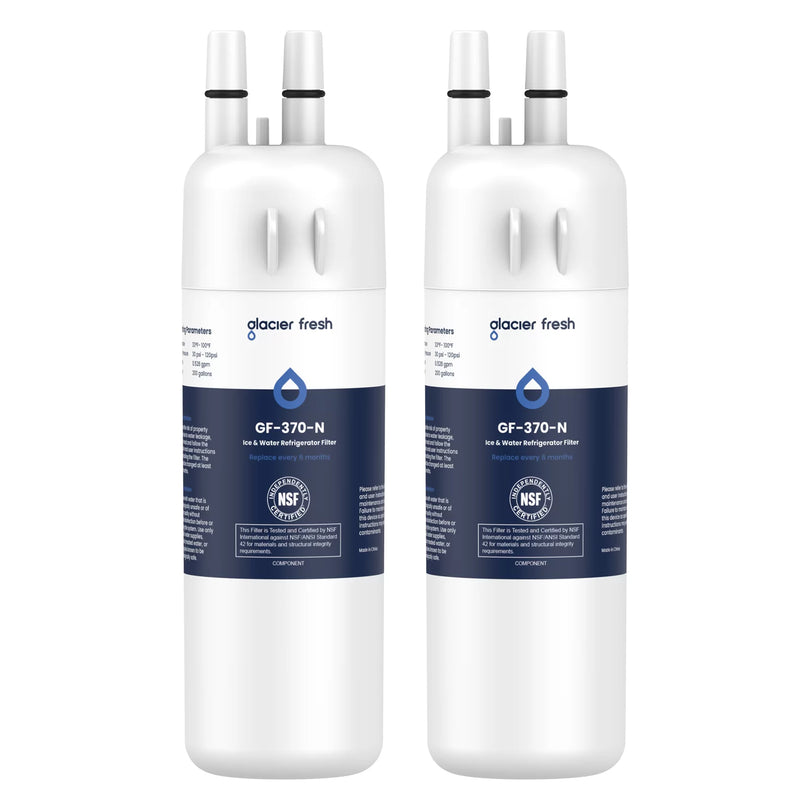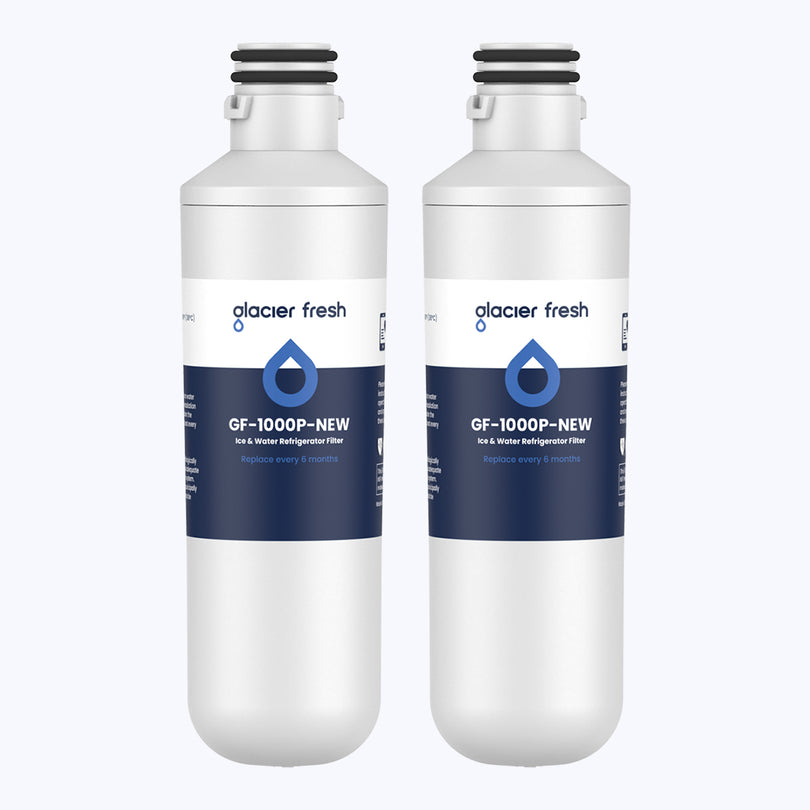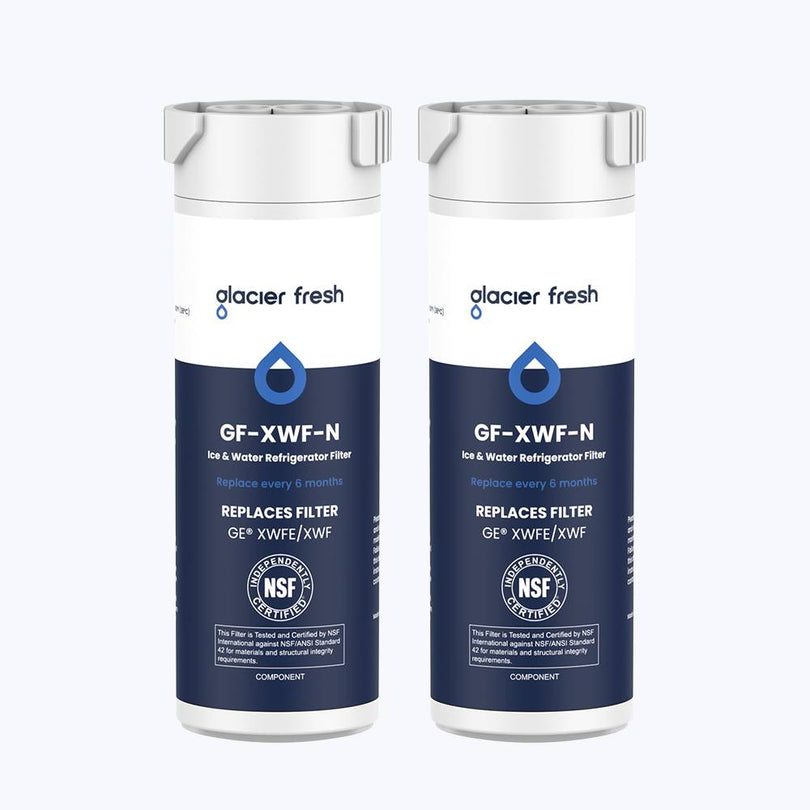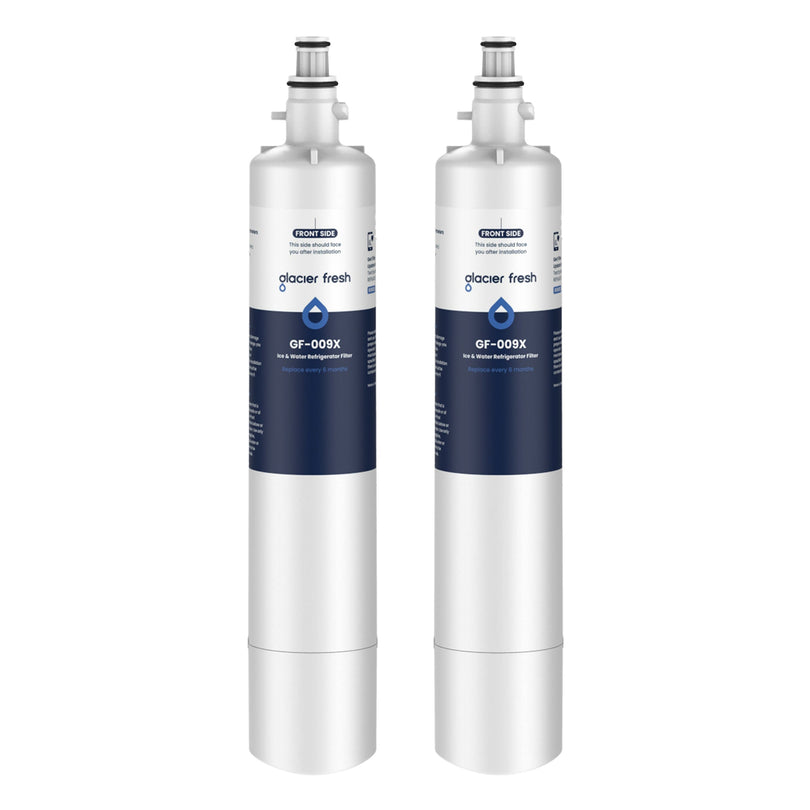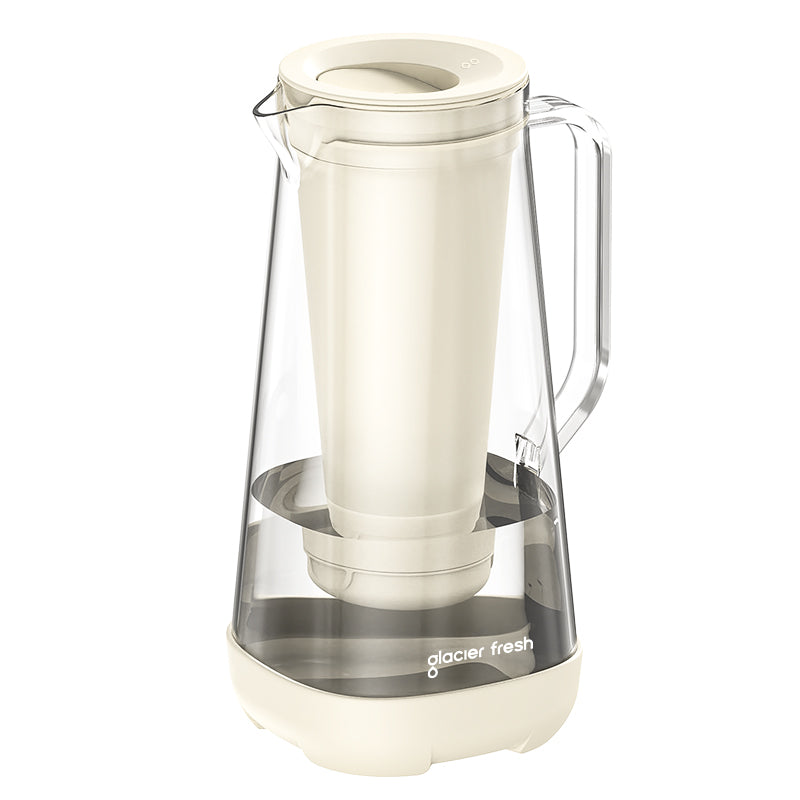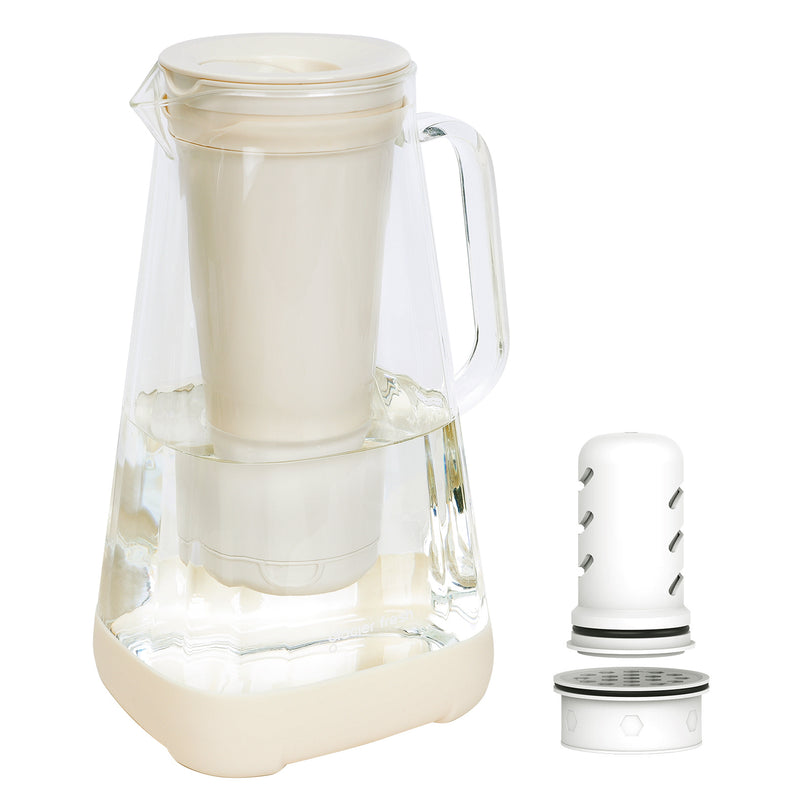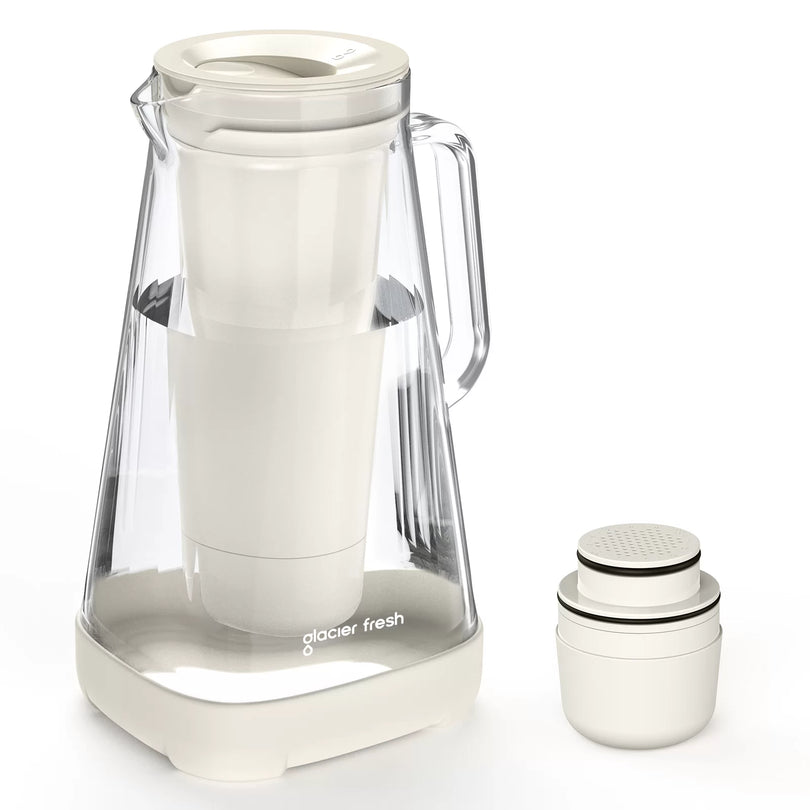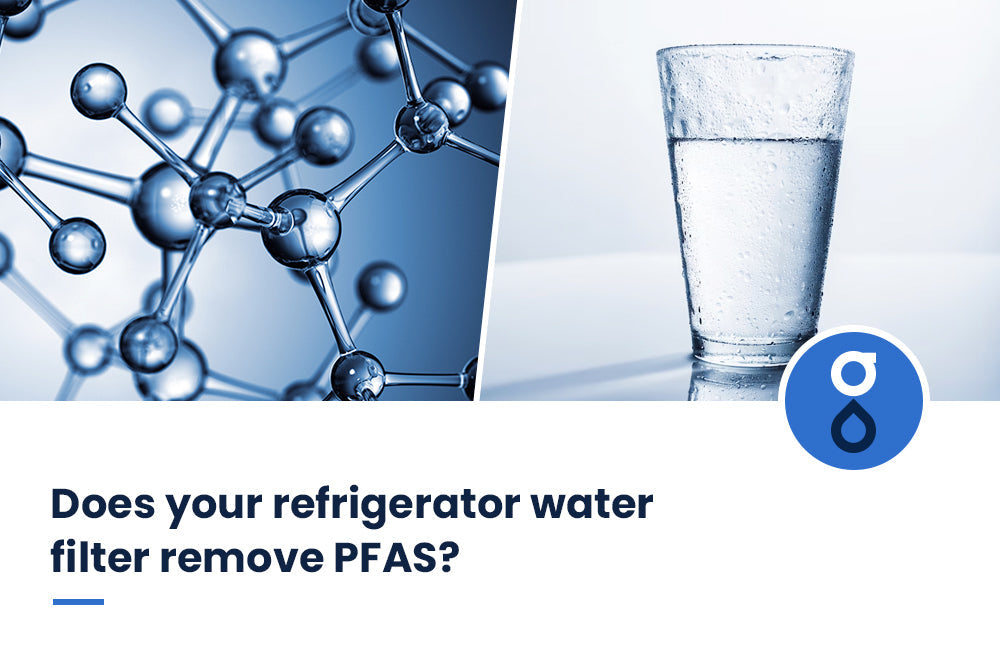Table of Contents:
Was sind PFAS
Arten von PFAS
Die potenziellen Gesundheitsrisiken einer PFAS-Exposition
Entfernen Ihre Kühlschrank-Wasserfilter PFAS?
So testen Sie Wasser auf PFAS
Methoden zur Reduzierung der PFAS-Exposition
FAQs
Abschluss
Falsch, falsch! Wissen Sie, was PFAS sind? Es handelt sich um eine Klasse künstlicher Chemikalien, die in verschiedenen Produkten unseres Alltags verwendet werden. Leider sind PFAS in vielen Trinkwasserquellen enthalten und können unsere Gesundheit schädigen. Deshalb ist es wichtig zu wissen, ob Ihr Kühlschrank-Wasserfilter PFAS aus Ihrem Trinkwasser entfernen kann.
In diesem Artikel sehen wir uns an, was PFAS sind, welche Arten von Kühlschrankwasserfiltern es gibt, wie effektiv sie PFAS entfernen und geben Tipps zur Auswahl des richtigen Filters und zur Entfernung von PFAS aus Trinkwasser.
Was sind PFAS?
PFAS (Per- und Polyfluoralkylsubstanzen) sind eine Gruppe künstlich hergestellter Chemikalien, die seit den 1950er Jahren in verschiedenen Industriezweigen und Konsumgütern wie antihaftbeschichtetem Kochgeschirr, schmutzabweisenden Teppichen, Feuerlöschschaum und Lebensmittelverpackungen weit verbreitet sind. Der Grund für ihre Beliebtheit ist ihre Hitze-, Wasser- und Ölbeständigkeit. PFAS-Chemikalien werden jedoch mit zahlreichen Gesundheitsproblemen in Verbindung gebracht, darunter Nieren- und Hodenkrebs, Hormonstörungen, Entwicklungsverzögerungen und Probleme bei der fetalen Entwicklung. Studien haben zudem gezeigt, dass sich diese Chemikalien im Körper anreichern und dort lange verbleiben können.

Zwei der am weitesten verbreiteten PFAS-Chemikalien sind PFOA (Perfluoroctansäure) und PFOS (Perfluoroctansulfonsäure). Diese Verbindungen werden in den USA aufgrund ihrer Gefährlichkeit schrittweise abgeschafft, obwohl PFAS-Chemikalien noch in anderen Produkten enthalten sind. Eines der besorgniserregendsten Probleme im Zusammenhang mit PFAS-Verbindungen ist ihr Vorhandensein im Trinkwasser. Eine PFAS-Kontamination kann auftreten, wenn diese Chemikalien in der Nähe von Anlagen, die sie verwenden oder entsorgen, in den Boden und das Grundwasser sickern. Von Trinkwasserverschmutzung wurde in der Nähe von Militärstützpunkten, Industrieanlagen und Gebieten, in denen Feuerlöschschaum verwendet wird, berichtet. Das Ausmaß der PFAS-Belastung der US-Bevölkerung wird noch untersucht, aber man geht davon aus, dass die meisten Menschen diesen schädlichen Chemikalien in gewissem Maße ausgesetzt waren. Die EPA hat einen Gesundheitsempfehlungswert von 70 Teilen pro Billion (ppt) für PFOA und PFOS im Trinkwasser festgelegt. Einige Staaten haben jedoch aufgrund von Bedenken hinsichtlich gesundheitsschädlicher Auswirkungen strengere Grenzwerte festgelegt.
Arten von PFAS
Unter diesen Oberbegriff fallen mehrere Arten von PFAS. Zu den am häufigsten untersuchten gehören Perfluoroctansäure (PFOA), Perfluoroctansulfonat (PFOS), Hexafluorpropylenoxid-Dimersäure (GenX), Perfluornonansäure (PFNA) und Perfluorbutansulfonat (PFBS).
PFOA
Perfluoroctansäure (PFOA) ist ein künstlicher chemischer Bestandteil einer größeren Gruppe von Chemikalien, die als Perfluoralkyl- und Polyfluoralkylsubstanzen oder PFAS bekannt sind. PFOA ist aufgrund seiner potenziellen Rolle bei der PFAS-Kontamination berüchtigt. PFOA wird in verschiedenen Industrie- und Verbraucherprodukten verwendet, darunter antihaftbeschichtetes Kochgeschirr, Beschichtungen für Teppiche und Textilien sowie Feuerlöschschäume. Seine chemischen Eigenschaften machen es für diese Anwendungen nützlich, da es ein starkes Tensid mit hoher Hitzebeständigkeit ist. Die Exposition gegenüber PFOA wird mit einer Reihe von gesundheitlichen Auswirkungen in Verbindung gebracht, darunter Auswirkungen auf den Cholesterinspiegel, Leberschäden und ein erhöhtes Risiko für bestimmte Krebsarten. Darüber hinaus wird es mit verringertem Geburtsgewicht und Entwicklungsverzögerungen bei Kindern in Verbindung gebracht.
PFOS
PFOS ist eine synthetische Verbindung mit einer hochstabilen Kohlenstoff-Fluor-Bindung, die sie widerstandsfähig gegen Umwelteinflüsse und in biologischem Gewebe beständig macht. Sie wurde hauptsächlich in antihaftbeschichtetem Kochgeschirr, schmutzabweisenden Textilien, wasserabweisender Kleidung und Beschichtungen für Industrieanlagen verwendet. Darüber hinaus war sie ein wichtiger Bestandteil von Feuerlöschschaum. Dank ihrer stabilen chemischen Bindung ist sie widerstandsfähig gegen Zersetzung und kann über längere Zeit in der Umwelt verbleiben.
Studien haben gezeigt, dass eine längere Belastung mit PFOS mit zahlreichen gesundheitsschädlichen Auswirkungen verbunden ist. Zu diesen Auswirkungen gehören ein niedriger Cholesterinspiegel, verringertes Geburtsgewicht und Entwicklungsstörungen bei Kindern. Darüber hinaus haben Studien gezeigt, dass die Belastung mit PFOS das Krebsrisiko, das Risiko einer Schädigung des Immunsystems und anderer Gesundheitsprobleme erhöhen kann. Um den zunehmenden Risiken durch PFOS-Belastung zu begegnen, hat die Environmental Protection Agency (EPA) Vorschriften im Rahmen des Safe Drinking Water Act erlassen. Die EPA empfahl einen Richtwert von 70 ppt (parts per trillion) für Trinkwasser, der in den letzten Jahren auf den noch niedrigeren Wert von 15 ppt gesenkt wurde. Diese Richtlinien haben dazu beigetragen, den PFOS-Gehalt im Trinkwasser zu begrenzen und Verbraucher vor potenziellen Gesundheitsgefahren zu schützen.
GenX
GenX ist eine Art per- und polyfluorierter Alkylsubstanz (PFAS), die in Trinkwasserquellen in den gesamten Vereinigten Staaten vorkommt. Diese Art von Substanzen wurde häufig in antihaftbeschichtetem Kochgeschirr sowie in militärischem Löschschaum verwendet. PFAS-Chemikalien werden mit gesundheitsschädlichen Auswirkungen in Verbindung gebracht, darunter Entwicklungs- und Fortpflanzungsstörungen, und GenX bildet hier keine Ausnahme.
Quellen der GenX-Kontamination sind Industrieanlagen, Militärstützpunkte und Kläranlagen. GenX kann auf verschiedenen Wegen in Wasserquellen gelangen, unter anderem durch direkte Einleitung aus Anlagen, die Chemikalien verwenden oder produzieren, sowie durch Abwasseraufbereitungsanlagen, die möglicherweise nicht alle PFAS-Substanzen entfernen können. GenX wird trotz seiner potenziellen Gesundheitsrisiken nicht von der Environmental Protection Agency (EPA) reguliert, und es wurde kein Richtwert festgelegt. Daher liegt es in der Verantwortung des Einzelnen, sicherzustellen, dass sein Trinkwasser ausreichend gefiltert wird, um diese schädliche Substanz zu entfernen.
PFNA
PFNA gehört zu einer Gruppe künstlicher Chemikalien, die Mitte des 20. Jahrhunderts entwickelt wurden und in zahlreichen industriellen und gewerblichen Anwendungen wie Feuerlöschschäumen, antihaftbeschichtetem Kochgeschirr und schmutzabweisenden Textilien zum Einsatz kommen. Mehrere Studien deuten darauf hin, dass PFNA verschiedene Organsysteme schädigen kann, darunter die Geschlechtsorgane, Nieren und Leber. PFNA-Exposition wird zudem mit einem erhöhten Cholesterinspiegel in Verbindung gebracht, und mehrere Studien haben ergeben, dass erhöhte PFNA-Werte mit einem erhöhten Auftreten von gesundheitsschädlichen Wirkungen einhergehen. Darüber hinaus zeigen neuere Forschungsergebnisse, dass PFNA das Immunsystem beeinträchtigen und ein Risiko für die Entwicklung des Fötus darstellen kann.
PFBS
Im Vergleich zu PFOA und PFOS, die ebenfalls zu den PFAS-Typen zählen, hat PFBS eine kürzere Kettenlänge und gilt als weniger toxisch. Es ist jedoch wichtig zu beachten, dass selbst geringe Mengen an PFAS potenziell gesundheitsschädlich sein können. PFBS ist bedenklich, da es in der Umwelt persistent ist und sich sowohl in der Umwelt als auch im menschlichen Körper anreichern kann. Diese Anreicherung hat Bedenken hinsichtlich der möglichen langfristigen Auswirkungen einer PFBS-Exposition auf die menschliche Gesundheit geweckt.
Während einige Wasserfiltermethoden, wie Kohlefilter und Umkehrosmoseanlagen, PFAS effektiv aus Trinkwasserquellen entfernen, ist es bei der Beurteilung der Wirksamkeit von Wasserfiltersystemen unerlässlich, PFBS zu berücksichtigen. Auch Kühlschrank-Wasserfilter entfernen PFAS effektiv aus Trinkwasser.
Die potenziellen Gesundheitsrisiken einer PFAS-Exposition
Eines der besorgniserregendsten Risiken ist die Auswirkung auf die Fruchtbarkeit. Studien haben gezeigt, dass eine höhere PFAS-Exposition die Fruchtbarkeit sowohl bei Männern als auch bei Frauen verringern kann. Die Exposition gegenüber PFAS während der Schwangerschaft wird zudem mit Entwicklungsverzögerungen und Verhaltensstörungen bei Kindern in Verbindung gebracht. Darüber hinaus wird die PFAS-Exposition mit hormonell bedingten Erkrankungen wie einer beschleunigten Pubertät und einem höheren Risiko für Nieren-, Prostata- und Hodenkrebs in Verbindung gebracht. Sie kann auch die Funktion des Immunsystems beeinträchtigen und den Cholesterinspiegel negativ beeinflussen, was möglicherweise zu Herz-Kreislauf-Erkrankungen führt.
PFAS sind in der Umwelt und im menschlichen Körper persistent, d. h. sie können lange Zeit bestehen bleiben, ohne abgebaut zu werden. Sie werden mit verschiedenen Krankheiten in Verbindung gebracht, wie z. B. Störungen des Schilddrüsenhormons, Lebererkrankungen und Krebs. Die potenziellen Gesundheitsrisiken im Zusammenhang mit der Exposition gegenüber PFAS sind vielfältig. Es ist wichtig, sich der mit diesen Chemikalien verbundenen Risiken bewusst zu sein und Maßnahmen zu ergreifen, um die Exposition nach Möglichkeit zu reduzieren.
Entfernen Ihre Kühlschrank-Wasserfilter PFAS?

Kühlschrank-Wasserfilter können zwar Geschmack und Geruch Ihres Trinkwassers verbessern, sind aber nicht für die Entfernung von PFAS-Chemikalien zertifiziert. Hausbesitzer, die sich über das Vorhandensein von PFAS in ihrem Leitungswasser Sorgen machen, sollten stattdessen alternative Wasserfilteroptionen wie Aktivkohlefilter , Umkehrosmoseanlagen oder Hauswasserfiltersysteme in Betracht ziehen. Diese Optionen entfernen PFAS und andere potenziell schädliche Chemikalien effektiv aus dem Trinkwasser.
Angenommen, Sie möchten Ihren Kühlschrank-Wasserfilter weiterhin verwenden. Tauschen Sie in diesem Fall die Filterkartusche alle sechs Monate aus und überwachen Sie den Wasserdurchfluss, um festzustellen, ob ein Filterwechsel erforderlich ist. Verbraucher sollten außerdem auf Wasserfilter achten, die nach NSF/ANSI 53 und NSF/ANSI 58 zertifiziert sind und PFAS und andere Schadstoffe wirksam entfernen. Darüber hinaus ist es wichtig, auf Kontaminationsstellen wie Militärstützpunkte und öffentliche Wassersysteme zu achten und Ihr Wasser regelmäßig testen zu lassen, um die Sicherheit und Qualität Ihres Trinkwassers zu gewährleisten.
So testen Sie Wasser auf PFAS
Die Prüfung auf PFAS-Chemikalien im Wasser wird aufgrund ihrer schädlichen Auswirkungen auf die menschliche Gesundheit immer wichtiger. Die Prüfung Ihres Wassers auf diese Chemikalien ist relativ einfach und kann Ihnen und Ihrer Familie Sicherheit geben.
Eine der zuverlässigsten Methoden, um Wasser auf PFAS zu testen, ist die Einsendung einer Probe an ein zertifiziertes Trinkwasserlabor. Diese Labore nutzen modernste Technologien, um selbst geringste Spuren dieser Chemikalien in Ihrem Wasser nachzuweisen. Alternativ können Sie ein privates Testpaket von einem Labor erwerben, wie beispielsweise den Tap Score PFAS-Wassertest von SimpleLab. Der Tap Score PFAS-Wassertest von SimpleLab ist erschwinglich für alle, die ihre Wasserqualität testen möchten. Dieser Test deckt 14 der gängigsten Chemikalien ab, darunter PFOA und PFOS. Der Test ist einfach und beinhaltet alles, was Sie brauchen.
Um Ihr Wasser mit dem SimpleLab Tap Score PFAS-Wassertest zu testen, entnehmen Sie eine Probe Ihres Brunnen- oder Leitungswassers gemäß den Anweisungen und senden Sie diese im mitgelieferten frankierten Karton an das Labor. So stellen Sie sicher, dass die Probe korrekt behandelt wird und in gutem Zustand im Labor ankommt. Die Ergebnisse erhalten Sie in etwa einer Woche zusammen mit einer Liste der nächsten Schritte, basierend auf den festgestellten PFAS-Werten in Ihrem Wasser.
Methoden zur Reduzierung der PFAS-Exposition
Vermeiden Sie Produkte, die PFAS enthalten

Antihaftbeschichtetes Kochgeschirr wie Teflonpfannen enthält PFAS-Chemikalien. Beim Erhitzen können diese Materialien giftige Dämpfe freisetzen, die grippeähnliche Symptome hervorrufen können, die als Teflon-Grippe bekannt sind. Wenn PFAS-beschichtetes Kochgeschirr zerkratzt oder beschädigt wird, können die Chemikalien in die Lebensmittel gelangen und langfristige Gesundheitsschäden verursachen. Auch Feuerlöschschaum enthält PFAS-Chemikalien. Dieser Schaum wird zum Löschen von Bränden verwendet, die durch brennbare Flüssigkeiten wie Benzin, Kerosin und Öl verursacht werden. Die Verwendung von Feuerlöschschaum wird jedoch mit Verunreinigungen auf Militärstützpunkten, Flughäfen und an anderen Kontaminationsorten in Verbindung gebracht. Und auch schmutzabweisende Textilien wie Teppiche und Polster enthalten PFAS-Chemikalien. Der Kontakt mit diesen Chemikalien kann unter anderem zu Entwicklungsverzögerungen, niedrigem Geburtsgewicht und hormonell bedingten Störungen führen.
Um den Kontakt mit diesen gefährlichen Chemikalien zu vermeiden, sollten Sie auf sicherere Alternativen zurückgreifen. Verwenden Sie beispielsweise anstelle von Teflonpfannen Kochgeschirr aus Gusseisen oder Edelstahl. Zum Löschen von Bränden sollten Sie andere Methoden als Löschschaum verwenden. Vermeiden Sie schmutzabweisende Stoffe und verwenden Sie stattdessen Naturmaterialien wie Wolle oder Baumwolle.
Verwendung von Wasserfiltersystemen
Wenn Sie nach einer Lösung suchen, um PFAS aus Ihrem Trinkwasser zu entfernen, sind auf dem Markt verschiedene Arten von Wasserfiltersystemen erhältlich.

Kohlefilter, die häufig in Wasserkrügen zu finden sind, können einige PFAS entfernen. Sie sind jedoch nicht in der Lage, alle Arten von PFAS zu entfernen, einschließlich der kurzkettigen. Diese Filter müssen regelmäßig gewechselt werden, was auf lange Sicht kostspielig sein kann. Empfehlenswerte Marken sind beispielsweise Brita und PUR. Umkehrosmoseanlagen sind hochwirksam bei der Entfernung von PFAS aus Wasser und zählen daher zu den am häufigsten empfohlenen Filtersystemen. Diese Systeme pressen Wasser durch eine semipermeable Membran, die alles auffängt, was größer als ein Wassermolekül ist, einschließlich PFAS und anderer schädlicher Chemikalien. Der Nachteil dieser Systeme ist ihr Preis, der in der Regel zwischen 200 und 400 US-Dollar liegt, und der jährliche Wechsel.
Ionisches Fluorgelharz ist eine weitere hochwirksame Möglichkeit, PFAS aus Wasser zu entfernen. Dieses System verwendet harzbeschichtete Fasern, die PFAS binden, einfangen und am Durchdringen hindern. Der Nachteil ist, dass dieses System relativ teuer und im Einzelhandel oder online seltener erhältlich ist.
Verzehr von Bio-Lebensmitteln
Untersuchungen haben gezeigt, dass PFAS auch in Lebensmitteln, insbesondere in Fleisch, Geflügel und Fisch, vorkommen können, die durch Löschschaum oder kontaminiertes Wasser verunreinigt sein können. Der Verzehr von Bio-Lebensmitteln kann jedoch dazu beitragen, die Aufnahme von PFAS zu reduzieren und so vor diesen schädlichen Auswirkungen zu schützen. Im Gegensatz zur konventionellen Landwirtschaft werden im ökologischen Landbau keine PFAS-haltigen Pestizide, Herbizide oder Düngemittel eingesetzt. Daher reichern sich in den produzierten Bio-Lebensmitteln nicht die gefährlichen Chemikalien an, die in der industriellen Landwirtschaft vorkommen.

Darüber hinaus werden biologisch angebaute Lebensmittel strengen Test- und Zertifizierungsprozessen unterzogen, um sicherzustellen, dass sie frei von zusätzlichen Verunreinigungen, einschließlich PFAS, sind. Der Zertifizierungsprozess trägt dazu bei, die Qualität und Reinheit der produzierten Lebensmittel sicherzustellen. Er schreibt außerdem regelmäßige Tests von Wasserquellen und Böden vor, um sicherzustellen, dass diese frei von gefährlichen Chemikalien sind. Durch den Verzehr von Bio-Lebensmitteln können Einzelpersonen ihre Aufnahme von PFAS und anderen schädlichen Chemikalien deutlich reduzieren.
Befolgen Sie die Entsorgungsanweisungen für PFAS-haltige Produkte
Es ist wichtig, auf die Entsorgung von PFAS-Produkten zu achten. Werden bei der Entsorgung dieser Produkte die Anweisungen auf dem Etikett nicht befolgt, kann dies zu einem erhöhten Risiko einer Umweltverschmutzung führen, insbesondere wenn die Produkte in Gewässer und Böden gelangen. Es ist wichtig zu wissen, wie und wo PFAS-haltige Produkte ordnungsgemäß entsorgt werden.
Viele Bundesländer haben beispielsweise spezielle Vorschriften für die ordnungsgemäße Entsorgung von Löschschäumen und anderen PFAS-haltigen Verbraucherprodukten wie antihaftbeschichtetem Kochgeschirr, Lebensmittelverpackungen und schmutzabweisenden Teppichen. In manchen Regionen kann dies bedeuten, dass solche Gegenstände zu Sondermülldeponien gebracht oder die örtlichen Behörden um weitere Informationen gebeten werden müssen. Darüber hinaus ist es wichtig, sich bei den örtlichen Behörden über etwaige Einschränkungen oder zusätzliche Vorschriften zur Entsorgung dieser Gegenstände zu informieren. So wird sichergestellt, dass PFAS nicht in eine Umwelt gelangen, die Schaden anrichten könnte.
FAQs
Gibt es Alternativen zu PFAS-haltigen Produkten?
Ja. Da PFAS in vielen alltäglichen Haushaltsgegenständen wie Kochgeschirr und Textilschutzmitteln verwendet werden, ist es wichtig, nach sichereren Alternativen zu suchen. Antihaft-Pfannen mit Keramikbeschichtung oder Edelstahl sind eine hervorragende Alternative zu herkömmlichen Antihaft-Pfannen. Kleidung aus Naturfasern ist eine weitere Option für Stoffe, die keine PFAS enthalten. Verwenden Sie außerdem umweltfreundliche Reinigungsmittel anstelle von Chemikalien, um die Belastung mit diesen giftigen Verbindungen zu reduzieren.
Gibt es Vorschriften oder Gesetze zur Reduzierung der PFAS-Belastung?
Weltweit werden Vorschriften und Gesetze zur Reduzierung der PFAS-Belastung umgesetzt. In den USA hat die US-Umweltschutzbehörde (EPA) einen Grenzwert für die maximale Schadstoffbelastung (MCLG) für zwei spezifische PFAS-Chemikalien, PFOA und PFOS, festgelegt. Die EPA hat außerdem eine nationale Gesundheitsempfehlung für PFAS-haltiges Trinkwasser herausgegeben und Vorschriften für die industrielle Einleitung dieser Verbindungen in Oberflächengewässer erlassen. Auch andere Länder wie Kanada und Australien haben Regeln zur Reduzierung der PFAS-Belastung erlassen.
Wie kann ich feststellen, ob ein Produkt PFAS enthält?
Es kann schwierig sein, festzustellen, ob ein Produkt PFAS enthält, da es Tausende verschiedener PFAS-Typen gibt und diese nicht bei allen Produkten auf dem Etikett aufgeführt sind. Sie können beispielsweise in der Zutatenliste nach Begriffen wie „Fluor“ oder „Perfluor“ suchen oder beim Hersteller nachfragen, ob ein Produkt PFAS enthält. Viele Bundesstaaten veröffentlichen Listen mit PFAS-haltigen Produkten. Daher empfiehlt es sich, sich bei Ihrem örtlichen Gesundheitsamt oder Ihrer Umweltbehörde nach weiteren Informationen zu erkundigen.
Abschluss
Zusammenfassend lässt sich sagen, dass ein Kühlschrank-Wasserfilter eine effektive Methode zur Entfernung von PFAS aus Trinkwasser sein kann. Die Wahl des richtigen Filters für Ihr Kühlschrankmodell ist entscheidend, da einige Filter bei der Entfernung von PFAS effektiver sein können als andere. Regelmäßiger Filterwechsel und regelmäßige Wartung gewährleisten die Effizienz Ihres Filters. Ein hochwertiger Kühlschrank-Wasserfilter kann dazu beitragen, den PFAS-Gehalt in Ihrem Trinkwasser zu reduzieren und die Gesundheit Ihrer Familie zu schützen. Folgen Sie Glacier Fresh, um weitere Wasserfilterlösungen zu entdecken.

